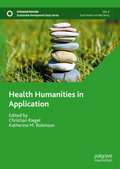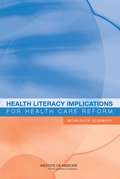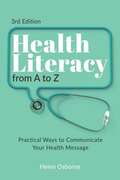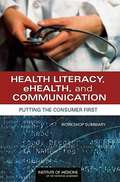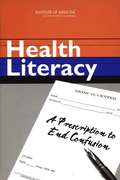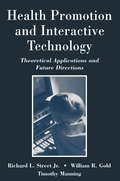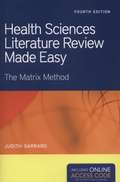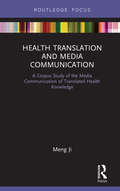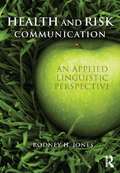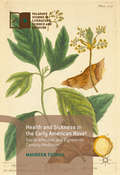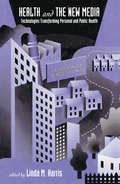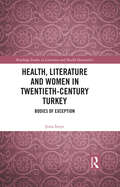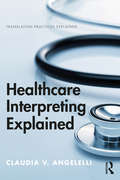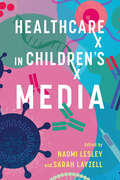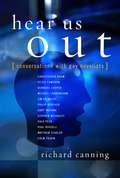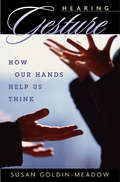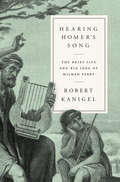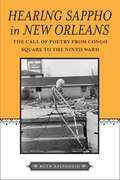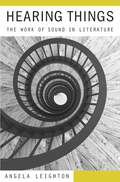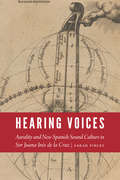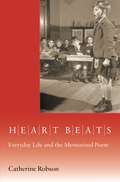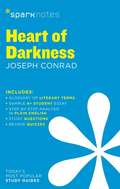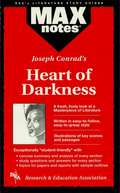- Table View
- List View
Health Humanities in Application (Sustainable Development Goals Series)
by Katherine M. Robinson Christian RiegelThis book focuses on health humanities in application. The field reflects many intellectual interests and practical applications, serving researchers, educators, students, health care practitioners, and community members wherever health and wellness and the humanities intersect. How we implement health humanities forms the core approach, and perspectives are global, including North America, Africa, Europe, and India. Emphasizing key developments in health humanities, the book’s chapters examine applications, including reproductive health policy and arts‑based research methods, black feminist approaches to health humanities pedagogy, artistic expressions of lived experience of the coronavirus, narratives of repair and re‑articulation and creativity, cultural competency in physician‑patient communication through dance, embodied dance practice as knowing and healing, interdisciplinarity and transdisciplinarity, eye tracking, ableism and disability, rethinking expertise in disability justice, disability and the Global South, coronavirus and Indian politics, visual storytelling in graphic medicine, and medical progress and racism in graphic fiction.
Health Literacy Implications for Health Care Reform: Workshop Summary
by Theresa WizemannHealth literacy is the degree to which one can understand and make decisions based on health information. Nearly 90 million adults in the United States have limited health literacy. While poor health literacy spans all demographics, rates of low health literacy are disproportionately higher among those with lower socioeconomic status, limited education, or limited English proficiency, as well as among the elderly and individuals with mental or physical disabilities. Studies have shown that there is a correlation between low health literacy and poor health outcomes. In 2010, President Obama signed the Affordable Care Act designed to extend access to health care coverage to millions of Americans who have been previously uninsured. Many of the newly eligible individuals who should benefit most from the ACA, however, are least prepared to realize those benefits as a result of low health literacy. They will face significant challenges understanding what coverage they are eligible for under the ACA, making informed choices about the best options for themselves and their families, and completing the enrollment process. Health Literacy Implications for Health Care Reform explores opportunities to advance health literacy in association with the implementation of health care reform. The report focuses on building partnerships to advance the field of health literacy by translating research findings into practical strategies for implementation, and on educating the public, press, and policymakers regarding issues of health literacy.
Health Literacy from A to Z: Practical Ways to Communicate Your Health Message
by Helen OsborneHealth Literacy from A to Z: Practical Ways to Communicate Your Health Message, Third Edition is for someone who cares a lot about communicating health messages in ways that patients and the public can understand. In other words, this book is written for you. It is intended as an easy-to-use guide. Its purpose is to inform and inspire you without being overwhelming. There are 43 stand-alone chapters arranged alphabetically from A to Z.
Health Literacy, eHealth, and Communication: Putting the Consumer First - Workshop Summary
by Institute of MedicineThere is great enthusiasm over the use of emerging interactive health information technologies-often referred to as eHealth-and the potential these technologies have to improve the quality, capacity, and efficiency of the health care system. However, many doctors, advocacy groups, policy makers and consumers are concerned that electronic health systems might help individuals and communities with greater resources while leaving behind those with limited access to technology. In order to address this problem, the Institute of Medicine's Roundtable on Health Literacy held a workshop to explore the current status of communication technology, the challenges for its use in populations with low health literacy, and the strategies for increasing the benefit of these technologies for populations with low health literacy. The summary of the workshop, "Health Literacy, eHealth, and Communication: Putting the Consumer First," includes participants' comments on these issues.
Health Literacy: A Prescription to End Confusion
by Institute of Medicine of the National AcademiesTo maintain their own health and the health of their families and communities, consumers rely heavily on the health information that is available to them. This information is at the core of the partnerships that patients and their families forge with today’s complex modern health systems. This information may be provided in a variety of forms – ranging from a discussion between a patient and a health care provider to a health promotion advertisement, a consent form, or one of many other forms of health communication common in our society. Yet millions of Americans cannot understand or act upon this information. To address this problem, the field of health literacy brings together research and practice from diverse fields including education, health services, and social and cultural sciences, and the many organizations whose actions can improve or impede health literacy. Health Literacy: Prescription to End Confusion examines the body of knowledge that applies to the field of health literacy, and recommends actions to promote a health literate society. By examining the extent of limited health literacy and the ways to improve it, we can improve the health of individuals and populations.
Health Promotion and Interactive Technology: Theoretical Applications and Future Directions (Routledge Communication Series)
by Richard L. Street William R. Gold Timothy ManningThis book's purpose is to offer various perspectives relating to the development, effectiveness, and implementation of interactive computing technology for health promotion--programs and interventions aimed at improving various health-related outcomes such as involvement in care, quality of life, adherence, disease management, healthy lifestyle, and more. Its coverage includes: *conceptual foundations for examining how characteristics of media, messages, and users relate to one another and how interactive media can effectively and appropriately promote health outcomes; *examinations of the development, utilization, and evaluation of specific computer applications for health promotion featuring discussions of the theoretical rationale for the program, the targeted audience, research on the program's effectiveness, and implications for future program development; and *analyses of critical issues such as potential benefits and limitations of technology on the delivery of care, institutional obstacles to the adoption of computing technology, and prospects for integrating information technology into the health system.
Health Sciences Literature Review Made Easy: The Matrix Method (Fourth Edition )
by Judith GarrardHealth Sciences Literature Review Made Easy, Fourth Edition is an essential text for your nursing research course and provides students with a solid foundation and the tools they need to evaluate articles and research effectively. The Fourth Edition builds on the digital updates made to the previous edition and highlights the Matrix Method and the skills necessary to critically evaluate articles. The text also covers Method Maps, which teach students how to effectively construct a research study. The author leads students through the process of how to manage a quality literature review in the context of evidence-based practice. A case study highlighting a typical graduate student is woven throughout the text to illustrate the importance of literature reviews and evidence-based practice. Health Sciences Literature Review Made Easy, Fourth Edition is appropriate for graduate level nursing courses as well as undergraduate Nursing Research courses that require literature reviews. Key Features: • Data Visualization: A Digital Exploration is an interactive, online appendix • The Matrix Method teaches the essential skills around literature evaluation • A real-life scenario case study is woven throughout each chapter to reinforce key concepts • Completely updated chapter on the guidelines for Methodological Review • Method Maps are introduced to convey the thought process around designing a research study
Health Translation and Media Communication: A Corpus Study of the Media Communication of Translated Health Knowledge (Routledge Studies in Empirical Translation and Multilingual Communication)
by Meng JiCross-sectoral interaction and cooperation in the communication of nutritional health risks represents a strategic research area among national governments and international health authorities. The key research question this book addresses is whether and how different industrial sectors interact with each other in the communication and industrial utilisation of health research findings. Through the introduction and exploration of large-scale industry news and digital media resources, this book systematically analyses a range of digital news genres and identifies new and growing trends of inter-sectoral interaction around the communication of nutritional health in the Chinese language at both international and national levels. This book argues that cross-sectoral interaction can be explored to identify areas that require policy intervention to increase the efficiency and effectiveness of current health communication and promotion. Inter-sectoral interaction can also provide incentives to develop new social programmes and business models to innovate and transform traditional industrial sectors.
Health and Risk Communication: An Applied Linguistic Perspective
by Rodney JonesHealth and Risk Communication provides a critical and comprehensive overview of the core issues surrounding health and risk communication from the perspective of applied linguistics. It outlines the ways applied linguistics differs from other methods of understanding health and risk communication, assesses the benefits and limitations of the approaches used by different scholars in the field, and offers an innovative framework for consolidating past research and charting new directions. Utilizing data from clinical interactions and everyday life, this book addresses a number of crucial questions including: How are the everyday actions we take around health constructed and constrained through discourse? What is the role of texts in influencing health behaviour, and how are these texts put together and interpreted by readers? How are actions and identities around health and risk negotiated in situated social interactions, and what are the factors that influence these negotiations? How will new technologies like genetic screening influence the way we communicate about health? How does communication about health and risk help create communities and institutions and reflect and reproduce broader ideologies and patterns of power and inequality within societies? Health and Risk Communication: An Applied Linguistic Perspective is essential reading for advanced students and researchers studying and working in this area.
Health and Sickness in the Early American Novel: Social Affection and Eighteenth-Century Medicine (Palgrave Studies in Literature, Science and Medicine)
by Maureen TuthillThis book is a study of depictions of health and sickness in the early American novel, 1787-1808. These texts reveal a troubling tension between the impulse toward social affection that built cohesion in the nation and the pursuit of self-interest that was considered central to the emerging liberalism of the new Republic. Good health is depicted as an extremely positive social value, almost an a priori condition of membership in the community. Characters who have the “glow of health” tend to enjoy wealth and prestige; those who become sick are burdened by poverty and debt or have made bad decisions that have jeopardized their status. Bodies that waste away, faint, or literally disappear off of the pages of America’s first fiction are resisting the conditions that ail them; as they plead for their right to exist, they draw attention to the injustice, apathy, and greed that afflict them.
Health and the New Media: Technologies Transforming Personal and Public Health (Routledge Communication Series)
by Linda M. HarrisThis book presents an evaluation framework for assessing the impact of the new media on the health care system by juxtaposing characteristics of emerging information and communication technologies (interactive, seamlessly connected, and user-driven) and health care objectives (to increase access, improve quality, and manage costs). Each chapter provides a unique set of tools and perspectives on how to harness these new media to improve individual health and the health care delivery system. This innovative volume has also stimulated the creation of a "Forum on Health and the New Media" on the World Wide Web (http://Health.Dartmouth.edu/NewMedia/). The forum offers highlights of the book as well as links to the authors and related web sites.The volume is divided into six sections as follows: *The "Overview" juxtaposes characteristics of the new media (interactive, connected, and user-driven) with the three criteria for health care improvement: increased access, improved quality, and cost management. It offers a New Media and Health Care matrix of criteria for building and evaluating emerging health care systems.*The "Delivery" -- how new media can enhance the delivery of health care -- includes chapters on: managed care, demand management and self-care, telemedicine for rural residents, and how the Internet can be used to facilitate collaboration among health researchers and providers.*Health Information -- the life blood of health care -- addresses the potential for: extending the traditional flow of health information (from researchers to providers) to reach patients who want to share in decisions about their care; and the federal government's role in providing health information to the public.*Health Education discusses: integrating multimedia health programming for public schools; using networked multimedia and simulation technologies and new learning theories that promise to transform public health education; and educating health providers and patients through interactive media and drama.*Potholes Along the Highway provides a sobering balance to otherwise rather optimistic assumptions that a national information infrastructure will be forthcoming. *The New Media: Annotated Glossary provides computing and networking technology tools for readers who are not fluent in cyberlanguage.
Health, Literature and Women in Twentieth-Century Turkey: Bodies of Exception (Routledge Studies in Literature and Health Humanities)
by Şima İmşirHealth, Literature and Women in Twentieth-Century Turkey offers readers fresh insight into Turkish modernity and its discourse on health, what it excludes and how these potentialities manifest themselves in women’s fiction to shape the imagination of the period. Starting from the nineteenth century, health gradually became a focal topic in relation to the future of the empire, and later the Republic. Examining representations of health and illness in nationalist romances, melodramas and modernist works, this book will explore diseases such as syphilis, tuberculosis and cancer, and their representation in the literary imagination as a tool to discuss anxieties over cultural transformation. This book places Turkish literature in the field of health humanities and identifies the discourse on health as a key component in the making of the Turkish nation-building ideology. By focusing on the place of health and illness in canonical and non-canonised fiction, it opens a new field in Turkish literary studies.
Health, Literature and Women in Twentieth-Century Turkey: Bodies of Exception (Routledge Studies in Literature and Health Humanities)
by Şima İmşirHealth, Literature and Women in Twentieth-Century Turkey offers readers fresh insight into Turkish modernity and its discourse on health, what it excludes and how these potentialities manifest themselves in women’s fiction to shape the imagination of the period. Starting from the nineteenth century, health gradually became a focal topic in relation to the future of the empire, and later the Republic. Examining representations of health and illness in nationalist romances, melodramas and modernist works, this book will explore diseases such as syphilis, tuberculosis and cancer, and their representation in the literary imagination as a tool to discuss anxieties over cultural transformation. This book places Turkish literature in the field of health humanities and identifies the discourse on health as a key component in the making of the Turkish nation-building ideology. By focusing on the place of health and illness in canonical and non-canonised fiction, it opens a new field in Turkish literary studies.
Healthcare Interpreting Explained (Translation Practices Explained)
by Claudia V. AngelelliHealthcare Interpreting Explained is the first comprehensive user-friendly book on the practice of medical/healthcare interpreting. Written by a leading world authority and drawing on research carried out in Europe, the United States, Australia and Asia, this process-focussed text goes beyond terms and concepts to cover medical discourse, ethics and protocol, professionalization, cognitive factors, problem-solving strategies, assessment and more. Including summaries, tasks, further reading and a range of real-world examples, as well as audio files on the Translation Studies Portal, this is the essential text for all students and practicing interpreters in the areas of medical and healthcare interpreting.
Healthcare in Children's Media (Children's Literature Association Series)
by Naomi Lesley Sarah LayzellContributions by Anna Bugajska, Dayna Campbell, Dallas Ducar, Sudeshna Shome Ghosh, Melanie Goss, Joseph Holloway, Jeremy Johnston, Manjushri Karthikeyan, Jenise Katalina, Sarah Layzell, Naomi Lesley, Anna Macdonald, Vanessa E. Martínez-Renuncio, Nichole Mayweather-Banks, Madison Miner, Dawn Sardella-Ayres, Farriba Schulz, Carrie Spencer, Antje Tannen, Valerie A. Ubbes, and B.J. Woodstein Healthcare in Children’s Media, edited by Naomi Lesley and Sarah Layzell, is a collection of essays and interviews from scholars, activists, and practitioners grappling with crucial questions about representations of healthcare systems, both formal and informal, in children’s media. The volume focuses on systems of healthcare rather than individual narratives of illness. It examines how children are socialized into knowledge about healthcare. Essays explore critiques of existing systems embedded in children's literature, analyze how children’s books might be used for health literacy education, and examine children’s film and television for visions of alternative systems and solutions to ethical dilemmas. Contributors in Healthcare in Children’s Media draw upon interdisciplinary approaches including disability studies, gender studies, public health, bibliotherapy, and posthumanism. Essays examine care systems in the US, the UK, Germany, India, and Iran, and also offer a breadth of historical perspective ranging from the turn of the twentieth century through our present times and into projections of future bioethical and posthuman dilemmas. This volume adds fresh works to archives of health literacy books, with analytic perspectives on race and disability that medical writers might not consider.
Hear Us Out: Conversations with Gay Novelists
by Richard CanningThe author of the acclaimed Gay Fiction Speaks brings us new interviews with twelve prominent gay writers who have emerged in the last decade. Hear Us Out demonstrates how in recent decades the canon of gay fiction has developed, diversified, and expanded its audience into the mainstream.
Hear Us Out: Conversations with Gay Novelists (Between Men-Between Women: Lesbian and Gay Studies)
by Richard CanningThe author of the acclaimed Gay Fiction Speaks brings us new interviews with twelve prominent gay writers who have emerged in the last decade. Hear Us Out demonstrates how in recent decades the canon of gay fiction has developed, diversified, and expanded its audience into the mainstream. Readers will recognize names like Michael Cunningham, whose Pulitzer Prize–winning novel The Hours inspired the hit movie; and others like Christopher Bram, Bernard Cooper, Stephen McCauley, and Matthew Stadler. These accounts explore the vicissitudes of writing on gay male themes in fiction over the last thirty years—prejudices of the literary marketplace; social and political questions; the impact of AIDS; commonalities between gay male and lesbian fiction... and even some delectable bits of gossip.
Hearing Gesture: How Our Hands Help Us Think
by Susan Goldin-MeadowMany nonverbal behaviors—smiling, blushing, shrugging—reveal our emotions. One nonverbal behavior, gesturing, exposes our thoughts. This book explores how we move our hands when we talk, and what it means when we do so. Susan Goldin-Meadow begins with an intriguing discovery: when explaining their answer to a task, children sometimes communicate different ideas with their hand gestures than with their spoken words. Moreover, children whose gestures do not match their speech are particularly likely to benefit from instruction in that task. Not only do gestures provide insight into the unspoken thoughts of children (one of Goldin-Meadow’s central claims), but gestures reveal a child’s readiness to learn, and even suggest which teaching strategies might be most beneficial. In addition, Goldin-Meadow characterizes gesture when it fulfills the entire function of language (as in the case of Sign Languages of the Deaf), when it is reshaped to suit different cultures (American and Chinese), and even when it occurs in children who are blind from birth. Focusing on what we can discover about speakers—adults and children alike—by watching their hands, this book discloses the active role that gesture plays in conversation and, more fundamentally, in thinking. In general, we are unaware of gesture, which occurs as an undercurrent alongside an acknowledged verbal exchange. In this book, Susan Goldin-Meadow makes clear why we must not ignore the background conversation.
Hearing Homer's Song: The Brief Life and Big Idea of Milman Parry
by Robert KanigelFrom the acclaimed biographer of Jane Jacobs and Srinivasa Ramanujan comes the first full life and work of arguably the most influential classical scholar of the twentieth century, who overturned long-entrenched notions of ancient epic poetry and enlarged the very idea of literature.In this literary detective story, Robert Kanigel gives us a long overdue portrait of an Oakland druggist's son who became known as the "Darwin of Homeric studies." So thoroughly did Milman Parry change our thinking about the origins of Homer's Iliad and Odyssey that scholars today refer to a "before" Parry and an "after." Kanigel describes the "before," when centuries of readers, all the way up until Parry's trailblazing work in the 1930's, assumed that the Homeric epics were "written" texts, the way we think of most literature; and the "after" that we now live in, where we take it for granted that they are the result of a long and winding oral tradition. Parry made it his life's work to develop and prove this revolutionary theory, and Kanigel brilliantly tells his remarkable story--cut short by Parry's mysterious death by gunshot wound at the age of thirty-three.From UC Berkeley to the Sorbonne to Harvard to Yugoslavia--where he traveled to prove his idea definitively by studying its traditional singers of heroic poetry--we follow Parry on his idiosyncratic journey, observing just how his early notions blossomed into a full-fledged theory. Kanigel gives us an intimate portrait of Parry's marriage to Marian Thanhouser and their struggles as young parents in Paris, and explores the mystery surrounding Parry's tragic death at the Palms Hotel in Los Angeles. Tracing Parry's legacy to the modern day, Kanigel explores how what began as a way to understand the Homeric epics became the new field of "oral theory," which today illuminates everything from Beowulf to jazz improvisation, from the Old Testament to hip-hop.
Hearing Sappho in New Orleans: The Call of Poetry from Congo Square to the Ninth Ward (Southern Literary Studies)
by Ruth SalvaggioWhile sifting through trash in her flooded New Orleans home, Ruth Salvaggio discovered an old volume of Sappho's poetry stained with muck and mold. In her efforts to restore the book, Salvaggio realized that the process reflected how Sappho's own words were unearthed from the refuse of the ancient world. Undertaking such a task in New Orleans, she sets out to recover the city's rich poetic heritage while searching through its flooded debris. Hearing Sappho in New Orleans is at once a meditation on this poetic city, its many languages and cultures, and a history of its forgotten poetry. Using Sappho's fragments as a guide, Salvaggio roams the streets and neighborhoods of the city as she explores the migrations of lyric poetry from ancient Greece through the African slave trade to indigenous America and ultimately to New Orleans.The book also directs us to the lyric call of poetry, the voice always in search of a listener. Writing in a post-Katrina landscape, Salvaggio recovers and ponders the social consequences of the "long song" -- lyric chants, especially the voices of women lost in time -- as it resonates from New Orleans's "poetic sites" like Congo Square, where Africans and Indians gathered in the early eighteenth century, to the modern-day Maple Leaf Bar, where poets still convene on Sunday afternoons. She recovers, for example, an all-but-forgotten young Creole woman named Lélé and leads us all the way up to celebrated contemporary writers such as former Louisiana poet laureate Brenda Marie Osbey, Sybil Kein, Nicole Cooley, and Katherine Soniat.Hearing Sappho in New Orleans is a reminder of poetry's ability to restore and secure fragile and fragmented connections in a vulnerable and imperiled world.
Hearing Things: The Work of Sound in Literature
by Angela LeightonHearing Things is a meditation on sound’s work in literature. Drawing on critical works and the commentaries of many poets and novelists who have paid close attention to the role of the ear in writing and reading, Angela Leighton offers a reconsideration of literature itself as an exercise in hearing. An established critic and poet, Leighton explains how we listen to the printed word, while showing how writers use the expressivity of sound on the silent page. Although her focus is largely on poets—Alfred Tennyson, W. B. Yeats, Robert Frost, Walter de la Mare, Wallace Stevens, Elizabeth Bishop, Jorie Graham, and Alice Oswald—Leighton’s scope includes novels, letters, and philosophical writings as well. Her argument is grounded in the specificity of the text under discussion, but one important message emerges from the whole: literature by its very nature commands listening, and listening is a form of understanding that has often been overlooked. Hearing Things offers a renewed call for the kind of criticism that, avoiding the programmatic or purely ideological, remains alert to the work of sound in every literary text.
Hearing Voices: Aurality and New Spanish Sound Culture in Sor Juana Inés de la Cruz (New Hispanisms)
by Sarah FinleyHearing Voices takes a fresh look at sound in the poetry and prose of colonial Latin American poet and nun Sor Juana Inés de la Cruz (1648/51–95). A voracious autodidact, Sor Juana engaged with early modern music culture in a way that resonates deeply in her writing. Despite the privileging of harmony within Sor Juana’s work, however, links between the poet’s musical inheritance and subjects such as acoustics, cognition, writing, and visual art have remained unexplored. These lacunae have marginalized nonmusical aurality and contributed to the persistence of both ocularcentrism and a corresponding visual dominance in scholarship on Sor Juana—and indeed in early modern cultural production in general. As in many areas of her work, Sor Juana’s engagement with acoustical themes restructures gendered discourses and transposes them to a feminine key. Hearing Voices focuses on these aural conceits in highlighting the importance of sound and—in most cases—its relationship with gender in Sor Juana’s work and early modern culture. Sarah Finley explores attitudes toward women’s voices and music making; intersections of music, rhetoric, and painting; aurality in Baroque visual art; sound and ritual; and the connections between optics and acoustics. Finley demonstrates how Sor Juana’s striking aurality challenges ocularcentric interpretations and problematizes paradigms that pin vision to logos, writing, and other empirical models that traditionally favor men’s voices. Sound becomes a vehicle for women’s agency and responds to anxiety about the female voice, particularly in early modern convent culture.
Heart Beats: Everyday Life and the Memorized Poem
by Catherine RobsonMany people in Great Britain and the United States can recall elderly relatives who remembered long stretches of verse learned at school decades earlier, yet most of us were never required to recite in class. Heart Beats is the first book to examine how poetry recitation came to assume a central place in past curricular programs, and to investigate when and why the once-mandatory exercise declined. Telling the story of a lost pedagogical practice and its wide-ranging effects on two sides of the Atlantic, Catherine Robson explores how recitation altered the ordinary people who committed poems to heart, and changed the worlds in which they lived. Heart Beats begins by investigating recitation's progress within British and American public educational systems over the course of the nineteenth and twentieth centuries, and weighs the factors that influenced which poems were most frequently assigned. Robson then scrutinizes the recitational fortunes of three short works that were once classroom classics: Felicia Hemans's "Casabianca," Thomas Gray's "Elegy Written in a Country Churchyard," and Charles Wolfe's "Burial of Sir John Moore after Corunna." To conclude, the book considers W. E. Henley's "Invictus" and Rudyard Kipling's "If--," asking why the idea of the memorized poem arouses such different responses in the United States and Great Britain today. Focusing on vital connections between poems, individuals, and their communities, Heart Beats is an important study of the history and power of memorized poetry.
Heart Of Darkness Notes
by Joseph ConradThese Notes present a clear discussion of the action and thought of the work under consideration and a concise interpretation of its artistic merits and its significance. They are intended as a supplementary aid to the serious student. They serve to free the student from interminable and distracting note-taking in class so that he may listen intelligently to what the instructor is saying, or to the class discussion, making selective notes on these, secure in the knowledge that he has the basic understanding. They are also helpful in preparing for an examination, saving not merely the burden but the confusion of trying to re-read the full text under pressure, and disentangling from a mass of—often illegible —notes that which is of central importance.
Heart of Darkness (MAXNotes Literature Guides)
by Frank FiorenzaREA's MAXnotes for Joseph Conrad's Heart of Darkness MAXnotes offer a fresh look at masterpieces of literature, presented in a lively and interesting fashion. Written by literary experts who currently teach the subject, MAXnotes will enhance your understanding and enjoyment of the work. MAXnotes are designed to stimulate independent thought about the literary work by raising various issues and thought-provoking ideas and questions. MAXnotes cover the essentials of what one should know about each work, including an overall summary, character lists, an explanation and discussion of the plot, the work's historical context, illustrations to convey the mood of the work, and a biography of the author. Each chapter is individually summarized and analyzed, and has study questions and answers.
